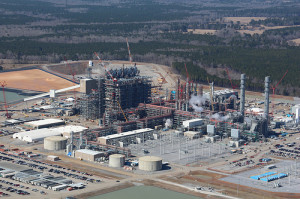Mississippi Power fires back at Kemper Project foes

KEMPER: The Kemper Project power plant converts lignite coal, mined near the power plant, for conversion into natural gas-like syngas to fire its turbines and generate electricity.
By Steve Wilson | Mississippi Watchdog
Mississippi Power has fired back at critics of its Kemper Project. The plant will convert lignite coal to natural gas-like syngas to fire its 582-megawatt turbines.
It’s scheduled to open later this year, said Jeff Shepard, a public relations specialist for the power company. The plant, he said, will bring “cleaner air and a diminished footprint on our environment while at the same time achieving a diverse fuel supply.”
Carbon dioxide output will equal that of natural gas-fired plants, due to an advanced carbon capture project. The company says the plant will capture 65 percent of carbon dioxide emissions.
But is this claim a lot of hot air?
According to a 2013 report by Element VI Consulting, the technology “consumes an enormous amount of power, and to generate a given amount of electricity for sale, a carbon-capture system plant needs to be at least 25 percent larger — and so emit 25 percent more carbon dioxide before sequestration — than an equivalent non-CCS plant. So reducing a CCS plant’s emissions by 65 percent actually equates to a 55 percent reduction for a non-CCS counterpart.”
Even that much carbon capture doesn’t come cheaply. According to the Energy Information Administration, capital costs for single-unit integrated gas closed cycle with a carbon capture system’s capital is $6,599 per kilowatt. Compared with $917 for a conventional closed-cycle natural gas plant, $1,023 for an advanced plant and $2,095 for one with a carbon capture system, that’s not exactly a bargain.
What’s more, the plant was built with $270 million from the Department of Energy, as part of $3.4 billion from the 2009 stimulus for carbon-capture technology.
The cost difference between a nuclear facility and a IGCC plant such as Kemper is striking. According to the EIA, “overnight capital costs (the cost before interest) associated with building a nuclear power plant in 2012 were $5,429 (2011 dollars) per kilowatt, which translates to almost $12 billion for a dual-unit 2,200-megawatt power plant.”
Using those numbers, a nuclear plant with similar power-generating capability would cost $3.2 billion.
Shepard said the $5 billion price tag for the power plant is inaccurate. That figure was for the “total project cost.”
It’s a bit of verbal gymnastics, but the facility, known as Plant Ratcliffe, can’t be divorced from the nearby lignite mine feeding its Transport Integrated Gasification system, a process untested on a large scale.
“With relation to the settlement agreement reached between Mississippi Power and the Public Service Commission in January 2013, customers will be asked to only pay $2.4 billion for the plant portion of the project, along with other costs that were included in the original certificate.”
Shepard failed to mention a bond of up to $1 billion, that passed last year, to cover additional costs for the project that will be paid by ratepayers.
Kemper isn’t the only IGCC power plant with issues. A similar plant in Edwardsport, Ind., is operational but not at full capacity. According to the Indianapolis Business Journal, the Duke Energy plant is generating only 4 percent of its capability due to mechanical problems and was plagued with cost overruns.
Contact Steve Wilson at swilson@watchdog.org
The post Mississippi Power fires back at Kemper Project foes appeared first on Watchdog.org.







